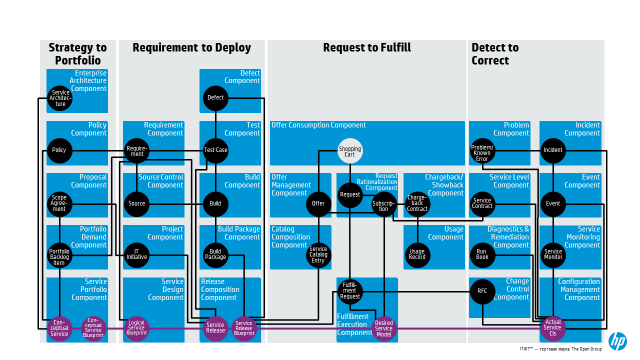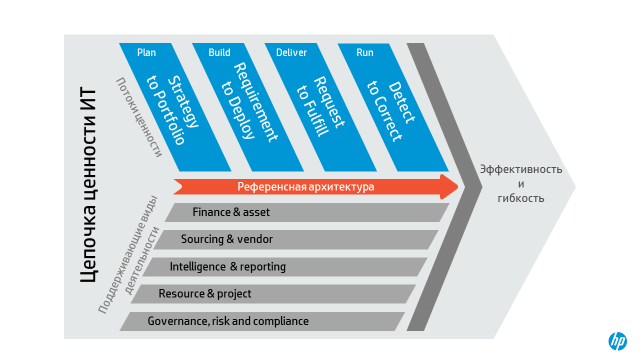Reference IT Management Architecture
In the field of IT management, a number of standards and best practices are traditionally used by companies as a guide: ITIL, MOF, TOGAF, PMBoK, BABOK, RUP, etc. However, experts always wanted to put all these things together to get an overall picture of IT management. In 2014, the first public version of IT4IT was released - an open standard and reference IT management architecture. IT4IT is published on behalf of The Open Group - a respected IT organization that owns numerous standards, such as TOGAF for architecture or the Single UNIX Specification. The co-sponsors of IT4IT are large international companies: Shell, Hewlett Packard, Achmea, Accenture, AT & T, PWC, ING, University of South Florida, Nestle, Barclays, Procter & Gamble, NBC, Disney, etc.

Over the past 20 years, many large companies have been improving IT management. Many automation systems were deployed in this area, and management processes were developed and implemented in daily operations.
However, the process and system landscape of IT management was often a “patchwork quilt”. Different standards and best practices, such as ITIL, COBIT, PMBoK, TOGAF, and others, although refined with the goal of mutual consistency, were not perceived as a whole. Even worse is with the automation systems - the integration of the systems of even one vendor was not always a simple task, and if you have to integrate related solutions from different manufacturers, you need significant investments of time, money and effort. In this situation, a number of large companies organized the IT4IT consortium, within the framework of which the open standard of IT management was developed - IT4IT and the reference IT management architecture of the same name.
')
IT4IT is based on the concept of a value chain, described by Michael Porter in his book “Competitive Advantage”. All the activities of the IT organization were divided into four main value stream (value stream) and five auxiliary activities. The four value streams are combined and detailed in the form of an IT reference management architecture.
In this case, for the first time, much attention is paid to data and artifacts that operate on IT activity blocks (circles in illustrations connected by lines). After all, gaps in the transmitted data often serve as the cause of inefficient interfacing of processes and IT management automation systems. Such a study was done both at the level of the architecture as a whole (see illustration), and in more detail at the level of each value stream.

At the same time, IT4IT does not abolish existing standards and codes of best practices (ITIL, TOGAF, PMBoK, etc.), but rather acts as a “superstructure” that allows to put them together, and is not a set of recommendations, but a prescriptive standard. It is also important that IT4IT is a completely open standard. For more information about it, visit opengroup.org/IT4IT.
Hewlett Packard Enterprise participated in the development of IT4IT from the very beginning and, in fact, was the only software manufacturer involved in this project.
Now there is a clear overlap of HPE software products on the IT4IT reference architecture. HPE software development teams rely on IT4IT to provide standard integration between products.
In addition, the Hewlett Packard Enterprise consulting departments have in their portfolio a set of services for assessing and planning the development of the process and system landscape of IT management in accordance with IT4IT. Many companies successfully use automation systems and management processes, but sometimes, due to the lack of a missing link, one or another value stream cannot reveal its full potential. An expert look at a specific IT department from the point of view of IT4IT makes it possible to identify these gaps, plan and carry out work on the implementation of the missing components.
IT4IT can be used to assess the current state and plan the harmonious development of IT management - both in terms of processes and in terms of automation.


Background to IT4IT
Over the past 20 years, many large companies have been improving IT management. Many automation systems were deployed in this area, and management processes were developed and implemented in daily operations.
However, the process and system landscape of IT management was often a “patchwork quilt”. Different standards and best practices, such as ITIL, COBIT, PMBoK, TOGAF, and others, although refined with the goal of mutual consistency, were not perceived as a whole. Even worse is with the automation systems - the integration of the systems of even one vendor was not always a simple task, and if you have to integrate related solutions from different manufacturers, you need significant investments of time, money and effort. In this situation, a number of large companies organized the IT4IT consortium, within the framework of which the open standard of IT management was developed - IT4IT and the reference IT management architecture of the same name.
')
Principal approach
IT4IT is based on the concept of a value chain, described by Michael Porter in his book “Competitive Advantage”. All the activities of the IT organization were divided into four main value stream (value stream) and five auxiliary activities. The four value streams are combined and detailed in the form of an IT reference management architecture.
In this case, for the first time, much attention is paid to data and artifacts that operate on IT activity blocks (circles in illustrations connected by lines). After all, gaps in the transmitted data often serve as the cause of inefficient interfacing of processes and IT management automation systems. Such a study was done both at the level of the architecture as a whole (see illustration), and in more detail at the level of each value stream.

At the same time, IT4IT does not abolish existing standards and codes of best practices (ITIL, TOGAF, PMBoK, etc.), but rather acts as a “superstructure” that allows to put them together, and is not a set of recommendations, but a prescriptive standard. It is also important that IT4IT is a completely open standard. For more information about it, visit opengroup.org/IT4IT.
Hewlett Packard Enterprise’s participation in IT4IT
Hewlett Packard Enterprise participated in the development of IT4IT from the very beginning and, in fact, was the only software manufacturer involved in this project.
Now there is a clear overlap of HPE software products on the IT4IT reference architecture. HPE software development teams rely on IT4IT to provide standard integration between products.
In addition, the Hewlett Packard Enterprise consulting departments have in their portfolio a set of services for assessing and planning the development of the process and system landscape of IT management in accordance with IT4IT. Many companies successfully use automation systems and management processes, but sometimes, due to the lack of a missing link, one or another value stream cannot reveal its full potential. An expert look at a specific IT department from the point of view of IT4IT makes it possible to identify these gaps, plan and carry out work on the implementation of the missing components.
IT4IT can be used to assess the current state and plan the harmonious development of IT management - both in terms of processes and in terms of automation.

Source: https://habr.com/ru/post/299732/
All Articles